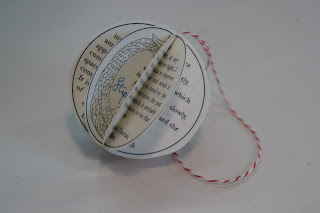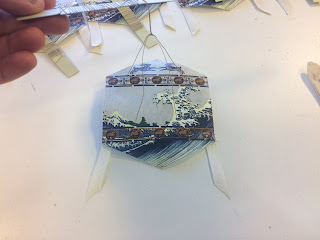The completion of the 2022 / 2023 holiday edition brings with it a completion of the holiday editions as a project. I started this tradition in my second year of graduate school, with the 2003 / 2004 cards, a project to fill the anxious moments of end of term assessments. During the intervening years, they’ve been a source of joy, an expression of curiosity, a way of trying out new techniques and new materials, and a chance to be frivolous in a way that my normal studio practice didn’t always permit. There have been years when the holiday edition has been the only purely creative project that I’ve undertaken; there have been years when my brain was ricocheting in hundreds of directions and the edition delivered well beyond the “holiday season;” there have been years when I’ve finished the edition and felt a great sense of accomplishment at the outcome.
And now it has been twenty years of holiday editions, and I feel like they have fulfilled their purpose. I have a more dedicated creative process which co-exists with my studio process; the edition itself has grown into a fuller artist-book undertaking than I ever intended for it to. In future years I will probably continue with holiday cards, but with reduced ambition, as my focus turns towards other ways of realizing my projects.
Wednesday, January 25, 2023
a score of editions
further thoughts of
Stephanie Gibbs
at
11:17 PM
![]()
as above, so below
The holiday edition has soared through the postal system, arriving in mailboxes near and far, in time for the Lunar new year. Its flight corresponds with the green comet that is wending its way past us this month, and caps a year when things mostly returned to normal, although many of us [me] aren’t quite sure what normal is supposed to be any more.

This year’s edition started with curiosity about two of the options offered by my printing company: the ability to print on mylar [polyester sheets], and the ability to print metallic ink. Could they … print metallic ink on mylar sheets, I asked? They’d try, they said, and: it worked! Since I generally achieve metallic outcomes using a kensol hot foil stamper, and since this would melt mylar rather than embossing images, I wanted to experiment to see what would happen.

From previous years [year of fog, sphere ornaments], I knew that mylar can’t be attached using glue, and so, in my first prototypes, I was concerned with finding a construction method that was adhesive free. Accordion books are traditionally great for this type of material, but I wanted something that played with the reflective qualities of the mylar, in addition to the translucence. While folding samples, I realized that a simple overlapped panel with a slit cut half-way through would allow the two panels to lock into position; and then, by sewing through the center folds, I could use a modified pamphlet stitch to anchor the star into shape.


Last year’s edition was the sea, and it felt appropriate for this year’s edition to be the stars. During the summer, photographs from the Hubble telescope made headlines; the year before, I had read a novel re-imagining the life of Kepler’s mother, who was tried as a witch while he was the astronomer royal. I’ve always loved the idea of the music of the stars, and believe that if any composer has the ability to translate that movement into sound, it would be the precision and balance of Bach, and found a manuscript of the Well Tempered Clavier to convey that song in these cards. While playing with the structure of the star, I added a belt, an echo of Saturn’s rings, and saw this as an opportunity to incorporate a line of text from Emerson’s essay, Circles: Our life is an apprenticeship to the truth that around every circle another can be drawn; that there is no end in nature, but every end is a beginning; that there is always another dawn risen on mid-noon, and under every deep a lower deep opens. The elements when brought together as a whole allow you to go deeper, into whichever direction you find inspiring.

While it seems like bad astronomy to have both rings and a comet tail, I liked the idea of folding a paper tassel to have both the message of well wishes for the new year and the colophon information dancing below the star, and was thrilled to discover that the Thai metallic paper from Hiromi Paper can be run through a standard laser printer. 

Once I received the printed paper inner star, and the printed mylar outer star, I created two jigs for scoring fold lines, punching sewing holes, and cutting slits for the paper ribbons. The inner star is smaller than the outer star, so that it nests inside the mylar, and so the measurements needed to be recalculated for each. After scoring and then folding the pages, I cut them into individual strips and began the initial stages of assembly.
The tassels were cut and folded; the ribbon rings woven through the mylar outer wrappers, and the wrappers locked into position; and the paper interior folded and also held in place with a slit-lock.
The tassels and the hanging ribbon were attached to the stars at the same time that the outer and inner layers were sewn together, using a modified pamphlet stitch with a backstitch element to anchor the star into the correct position.
Since the post office has a tendency to destroy my cards in transit, they always receive some type of wrapper to protect them on their way. This year the wrapper also included instructions for opening up the star for display — since I know it isn’t always obvious what, exactly, the holiday edition is.
My cats received a mini-edition of their own: originally, I was going to make a special “cats of recipients” edition-within-an-edition, but, even though I anticipated this year’s project being substantially less involved than last year’s, it still took a month to assemble after receiving the printed elements, and so the feline mini-edition was allowed to exist purely in the “conceptual” state.
Wishing you — and your cats — a very happy new year!
further thoughts of
Stephanie Gibbs
at
11:02 PM
![]()





































